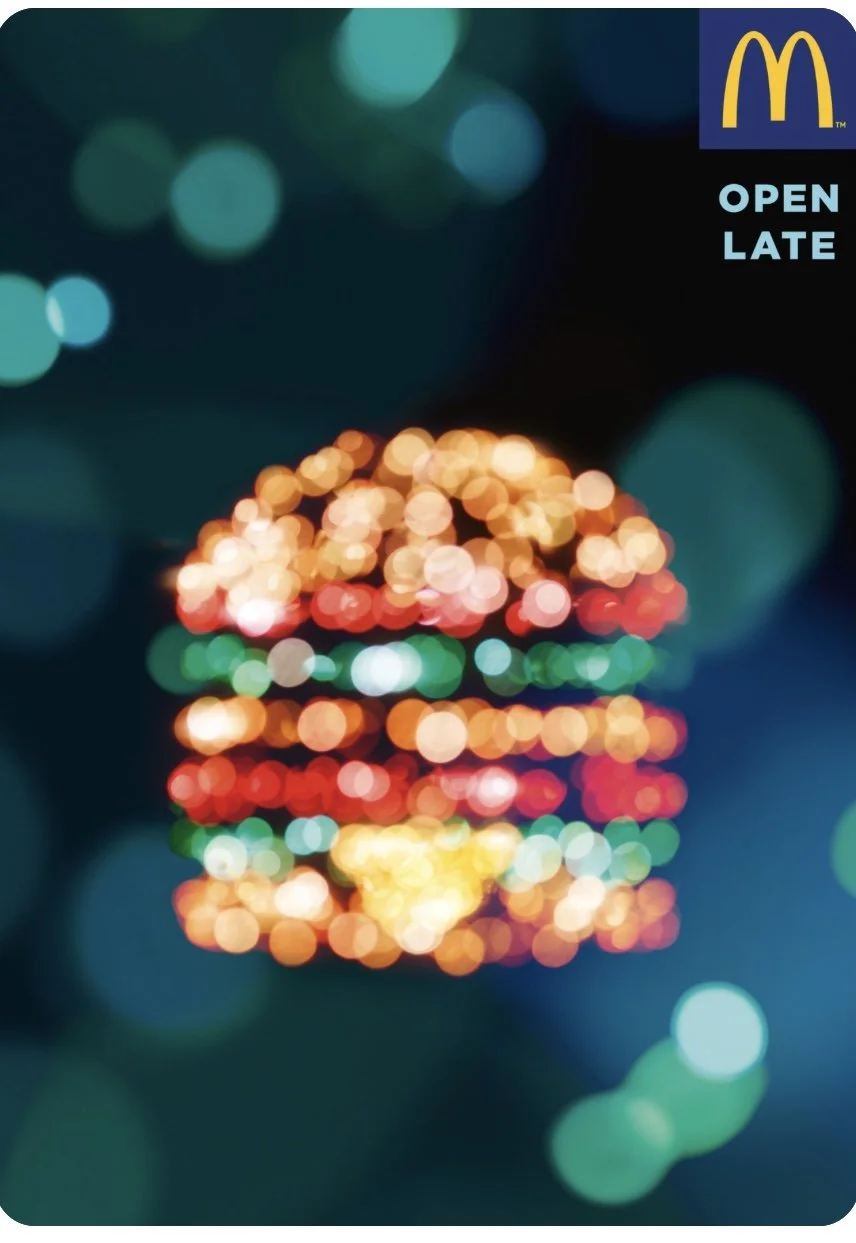PHO710: Positions and Practice, MA Photography CRJ Topic 4: Reading Photographs
TASK: Post an image of an advertising image. Write a few lines about what the brand or organisation is trying to communicate about the product or service being advertised.
McDonalds Poster Ad Campaign
Strong, graphic, stand out images, making clever use of photography to promote late opening hours. Less is more, using only the ‘Golden Arches’ to identify the brand, and minimal text ‘Open Late’, is well executed, simple and to the point.
Glowing bulbs have been photographed to form fuzzy but distinguishable shapes of the brand’s products - the Big Mac, Ice Cream Sundae etc. It took 10 days to construct the light sculptures, using 1000 LEDs, and 2 days to shoot.
Photographer: Helmut Stezenberger.
Comments from some of my cohort:
The idea and execution are first class, I agree but I see processed light making processed food. Jo Shepherd
Great photo of brand identity. I love how this image conveys not only the clearly obvious McDonald's brand, but also the welcoming invitation to visit their restaurants late into the evening. The soft and colorful image of the burger almost beckons the viewed to "come hither." Burgers anyone? Great post! Mat Chacon
Mcdonalds has really perfected the minimalist advertisement. There are very few food brands that can sell their product without a polished hero shot of exactly what they are trying to sell you. There is another Mcdonalds ad that is just the words of the materials used to make a hamburger on a black background. This post shows the ability to use a different approach when you can rely on brand identity to make a connection to the target market. Love the ads...not so much the product. Michael Samartzis
Visually striking! Strong concept! Although I'm not keen at all on the product... can this example count as an example of metonymy? the association of a product with the high emotions of nightlife, as visualised with the lights? I still struggle to some extent understanding and keeping semiotic codes apart. Rolf Kraehenbuehl
I love the clever use of light to create the shape of the burger. This also benefits from decades of brand recognition. Jess Morse
TASK: Consider these two examples of different Afghan women who are of a similar age. Write a short post reflecting on how you read these two images. What are their similarities and how do they differ?
My emotive response to these two professionally taken portrait images came from the eyes of each girl looking directly out of the frame to the camera lens and viewer, the latter being the designated subject of their intent gaze, projecting themselves to me as victims. Afghan Girl’s piercing green eyes are intense, fearful, and angry, whilst Bibi Aisha’s dark eyes ask you to look at what has been done to her, showing us clearly and openly the horrific injury and facial disfigurement she has suffered.
Both photos use head and shoulder compositions lit naturally, the girls are of similar age, dark haired, wearing head scarves denoting the context of their Afghan cultural and religious background. Afghan Girl’s torn and tattered clothing suggests she is poor or a refugee, Bibi’s apparel in contrast is colourful, clean, possibly silk fabric typical of traditional women’s Afghan dress.
Further research reveals that both photos became famous, and led to significant controversy. Photojournalist Steve McCurry made his career and fame making the portrait of refugee Sharbat Gula, Afghan Girl, in 1984, at the time of the Soviet occupation of Afghanistan, for National Geographic Magazine (used on its June 1985 cover, subsequently named its ‘most recognised photograph’). Her image became a symbolic representation of Afghanistan to the West and has been referred to as ‘the First World’s Third World Mona Lisa’ although I do not see any enigmatic smile, only fear and anger at being photographed.
This was confirmed in a 2002 interview in The Wire, an Indian magazine, in which she described her sentient anger at being photographed and published without consent, cited by the article’s writer: ‘McCurry was a complete stranger, and it is not welcome for a girl of traditional Pashtun culture to reveal her face, share space, make eye contact and be photographed by a man who does not belong to her family’.
Jodi Bieber’s portrait of Aisha was similarly used on the cover of August 2010 Time magazine at the time of the War in Afghanistan (2001-2021), resulting in controversy with critics who described it as ‘war porn’ that exploits Aisha, while others saw it as a conscientious and unconditional imperative to help and support the women of Afghanistan.
Bibliography and References:
https://en.wikipedia.org/wiki/Afghan_Girl#Criticism
(Last accessed: 19 June 2022)
HESFORD Wendy S. and Wendy KOZOL. 2005. Just Advocacy?: Women's Human Rights, Transnational Feminisms, and the Politics of Representation. Rutgers University Press.
RIBHU. 12 March 2019. "You'll Never See the Iconic Photo of the 'Afghan Girl' the Same Way Again". The Wire. (Last accessed 19 June 2022).
McCURRY, Steve. 10 April 2001. "National Geographic: Afghan Girl, A Life Revealed". The Washington Post. OCLC 56914684. Archived from the original on 1 June 2013. (Last accessed 19 June 2022).
LUTZ, Catherine and Jane COLLINS. 1991. The Photograph as an Intersection of Gazes: The Example of National Geographic. Visual Anthropology Review: Spring 1991 Volume 7 Number 1. Available at: www.anthrosource.net (Last accessed: 19 June 2022)
https://sites.psu.edu/cas204/files/2013/08/LutzCollins-NationalGeographic-gaze-vfretb.pdf
(Last accessed: 19 June 2022)
(Last accessed: 19 June 2022)
https://www.theguardian.com/artanddesign/2011/nov/20/photography-jodi-bieber-best-shot
(Last accessed: 19 June 2022)
(Last accessed: 19 June 2022)



